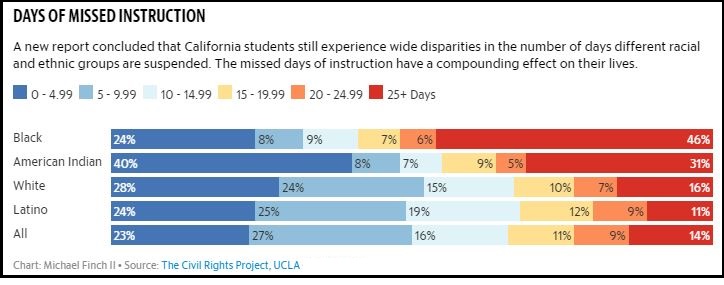
|
|

|
|
| April 20, 2024 |
|
California still suspending black and Native American students way more than whites 
LOS ANGELES--California has made strides to reduce student suspensions for minor classroom disruptions, but a new study concludes the state still has not gone far enough, and in some districts, pernicious disparities remain.
Statewide, school districts in 2017 issued some 381,845 suspensions that resulted in an estimated 763,690 missed days of instruction, according to a new report by the Center for Civil Rights Remedies at UCLA. The number of days lost for minor infractions categorized as “defiance and disruption” has fallen since 2011, but reform advocates say the decline has begun to taper off. The report comes as Gov. Jerry Brown considers whether to sign a bill that would ban suspensions for so-called “willful defiance” in all grades. Dan Losen, who co-authored the report, said awareness around the issue and a 2014 state law that banned suspensions in kindergarten through third grade has helped. “Across the state, there have been local community advocates and there’s been a lot of research before 2011 that says you do not have to remove students for defiance and disruption,” Losen said. “It’s hard to pinpoint exactly when the change started. Our concern is that it’s starting to level off.” Losen said the report highlights a number of troubling trends. · Black and Native American students who were suspended missed more days per capita than any other racial or ethnic group. The gap for black students of all ages compared to the statewide average was between 13 and 45 days and between 6 and 23 days for Native American students. · The disparities were also present in students with disabilities, who lost 22 more days of instruction than their peers. The gap widened by as much as 48 days if the students were black, 28 days if they were American Indian, and 23 days they were a Pacific Islander. · The number of instruction days lost due to suspension remains much higher for students in middle school, specifically seventh and eighth grades, than any other group. “The fact that it’s higher at the middle school level instead of the high school level could be an indicator that those students drop out,” Losen said. Although the report focuses on the issue at the statewide level, it does identify school districts where the disparities were the highest. One such place was Placer Union High School District, where Latino students who were suspended were out of class for 15 days more than their white peers. Placer Union oversees five high schools and its Latino students accounted for 14 percent of the district’s population. Kristin Conner, a district spokesperson, said the district is aware of the disparities that exist for Hispanic students, as well as those with disabilities and from low-income families. “These disparities are not unique to (Placer Union), but we have been actively working on closing these disparities and achievement gaps,” Conner said in an email. Conner said the disparities for many groups, including Latino students, have improved but there is still more to be done. “We are aware and agree that suspensions are not the most effective means of changing behavior, and we are currently involved in the implementation of restorative practices district-wide,” Conner said. “Moreover, each of our sites has goals that address closing the inequities and disparities.” Losen from UCLA said many school districts, including those in large urban areas like Los Angeles and Oakland, have found a way to reform their discipline policies, although some have been forced by lawsuits and settlement agreements. Change is possible, he said, as shown by the downward trend in recent years. “I think it has more to do with how entrenched the educators and administrators’ attitudes are,” Losen said. “Every district can find the mixture that works for them.” (Source: The Sacramento Bee) Story Date: September 21, 2018
|